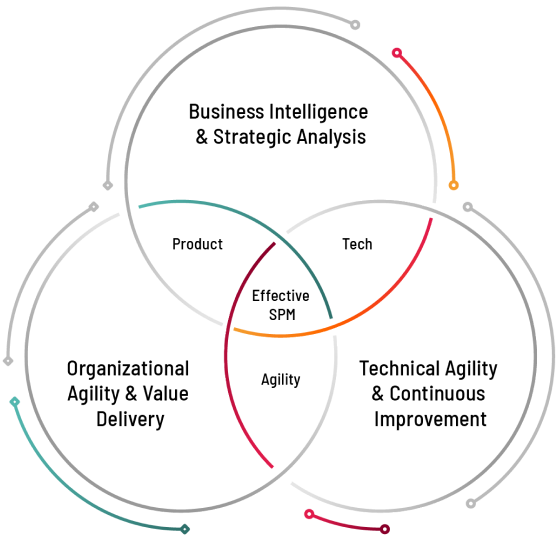From Synchronization to Innovation: Advancing Enterprise Maturity with Strategic Portfolio Management
The journey to enterprise maturity is not a single leap but a progressive evolution. This post, the second in a three-part series, dives into the advanced stages of enterprise evolution based on Strategic Portfolio Management (SPM): Adaptable Innovation and Continuous Evolution. Building on foundational concepts explored in the first blog, this installment examines how organizations can transition from portfolio synchronization to a future-ready state where innovation thrives, and operations align seamlessly with strategy.
Let’s explore how to advance your organization’s SPM journey and lay the groundwork for sustainable growth and industry leadership.
Recap: Building a Strong Foundation for Growth
Before diving into the advanced stages, it’s essential to reflect on the groundwork laid in the initial phases of the enterprise’s journey to continuous evolution:
Stage 1: Solid Foundation
Organizations focused on establishing governance, standardizing data, and adopting basic project tracking. This stage is about creating visibility and enabling a shared understanding across teams.
Stage 2: Strategic Synergy
Efforts shifted toward aligning strategic objectives with departmental goals. Collaboration deepened, and governance became more formalized, ensuring transparency and better decision-making.
Stage 3: Portfolio Synchronization
The emphasis moved to embedding data-driven decision-making across the organization. Workflow optimization, dynamic resource allocation, and early AI integration helped create an interconnected operational environment.
These stages built a sustainable SPM framework, preparing organizations to embrace innovation and agility as they progress to Stage 4.
For an in-depth treatment of the 5 Stages of Enterprise Evolution, download our white paper, Strategic Portfolio Management: A Catalyst for Business Evolution in the Age of Disruption.
Stage 4: Adaptable Innovation – Shaping the Future
Adaptable Innovation represents a significant shift in how organizations operate. In this phase, enterprises move beyond reactive approaches to actively shaping their future through predictive capabilities, streamlined processes, and interconnected systems.
Data Transformation
In Stage 4, data evolves from being a static reporting tool to a predictive powerhouse. Organizations leverage AI-driven analytics to foresee risks, identify opportunities, and allocate resources with precision. This transformation empowers leaders to act proactively, making informed decisions that drive innovation and efficiency.
Process Evolution
Governance transforms from rigid, annual cycles to dynamic, continuous processes. Organizations adopt adaptive frameworks that allow for real-time adjustments based on changing internal and external factors. This evolution fosters agility and positions enterprises to pivot quickly in response to market demands.
System Integration
Disjointed systems and siloed teams give way to unified platforms that enable seamless collaboration. By creating a single source of truth, organizations eliminate inefficiencies and enhance coordination across departments, ensuring that all efforts align with strategic objectives.
During the webinar, our experts emphasized the importance of starting small—focusing on a single high-impact use case—and scaling successes over time. This approach minimizes risk while maximizing the chances of long-term success.
Challenges on the Path to Adaptable Innovation
While the promise of adaptable innovation is compelling, the journey is not without its hurdles. Organizations often face several challenges when advancing to Stage 4:
- Siloed Operations: Disconnected teams and fragmented systems can hinder collaboration and slow decision-making.
- Resistance to Change: Cultural inertia and reluctance to adopt new processes can create roadblocks.
- Technological Limitations: Outdated tools and insufficient expertise can limit an organization’s ability to leverage predictive analytics and automation effectively.
Solutions for Overcoming Obstacles
The webinar provided actionable strategies to address these challenges:
- Invest in AI Capabilities: Predictive analytics and AI-powered decision-making tools can break down silos, enabling real-time insights and cross-functional collaboration.
- Foster a Culture of Adaptability: Encourage innovation by celebrating experimentation and empowering employees to take calculated risks.
- Establish Dynamic Governance: Replace bureaucratic approval processes with adaptive guardrails that facilitate innovation without compromising accountability.
By tackling these challenges head-on, organizations can accelerate their journey toward innovation-driven operations.
Looking Ahead: Stage 5 – Continuous Evolution
While Stage 4 focuses on enabling adaptability and fostering innovation, Stage 5, Continuous Evolution, represents the pinnacle of enterprise maturity. At this stage, organizations achieve seamless alignment between day-to-day operations and long-term strategic goals, maintaining a state of perpetual readiness for change.
What Defines Continuous Evolution?
- Autonomous Portfolio Management: Advanced AI systems take over routine decision-making, optimizing portfolios in real time without human intervention.
- Strategic Foresight: Organizations leverage predictive analytics to identify emerging trends and market opportunities before they become evident.
- Industry Leadership: Enterprises at this stage don’t just adapt to change—they drive it, setting new benchmarks for innovation and operational excellence.
Stage 5 transforms organizations into catalysts for change, empowering them to lead market disruptions rather than merely responding to them.
Embrace the Journey to Innovation
Advancing from synchronization to innovation is a pivotal step in the SPM maturity journey. Stage 4 empowers organizations to become more agile, responsive, and innovation-driven, setting the stage for Continuous Evolution in Stage 5. By addressing challenges and adopting a forward-thinking approach, enterprises can unlock new levels of efficiency, creativity, and impact.
To learn more about implementing adaptable innovation and preparing for continuous evolution, we invite you to view the full webinar recording. Gain deeper insights, hear real-world examples, and discover practical steps to accelerate your organization’s SPM journey.



